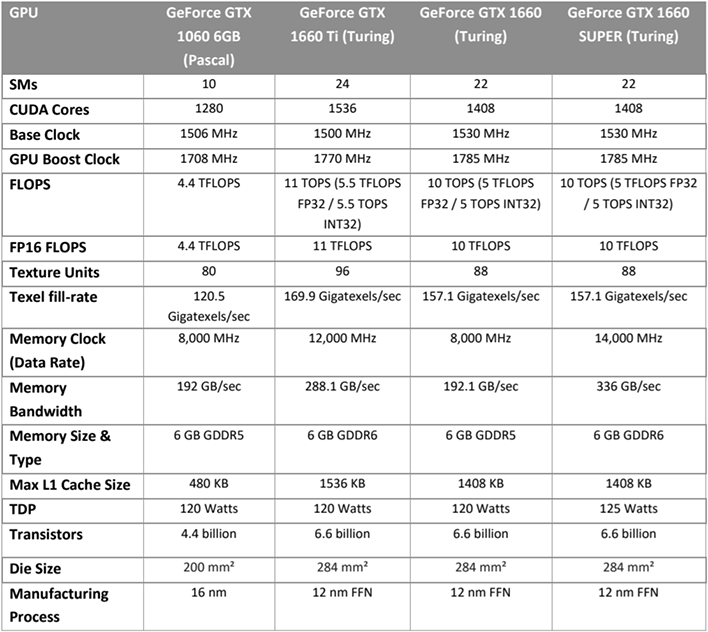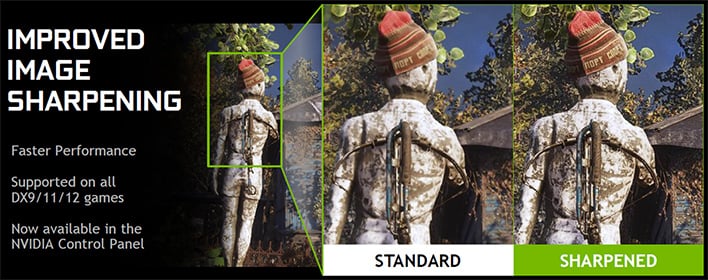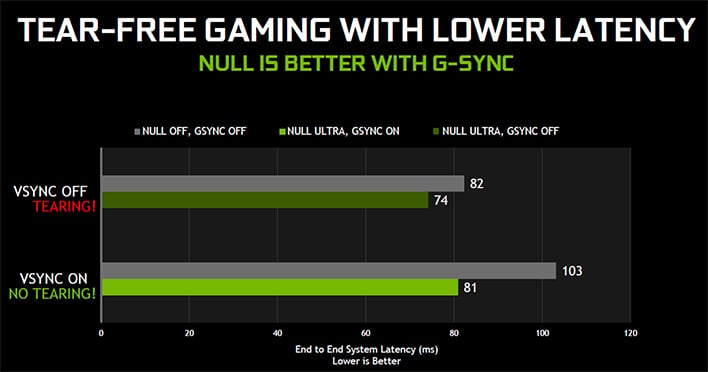GeForce GTX 1660 Super Review: Turbo Charged 1080p Gaming
We’ve got a couple of GeForce GTX 1660 Super cards on hand, one from Gigabyte and the other from ASUS. They are both in-house proprietary designs, as are all of the other 1660 Supers due to arrive – NVIDIA is leaving all of the designs up to their board partners this time around. NVIDIA did lay down a reference specification though, which we’ll break-down for you right here...
|
|
|
According to NVIDIA’s reference specifications, the GeForce GTX 1660 Super is somewhat of a cross of a standard GTX 1660 and a 1660 Ti. The GeForce GTX 1660 Super has a similar number of CUDA cores and texture units to the GTX 1660, but with GDDR6 memory like the Ti. Note, however, that the GeForce GTX 1660 Super has higher GPU and memory frequencies than the 1660 Ti. The GeForce GTX 1600 Super is also outfitted with faster 14 Gbps GDDR6 memory, which results in 336GB/sec of peak bandwidth versus the GTX 1660’s 192GB/sec and the 1660 Ti’s 288.1GB/s. That means in memory bandwidth bound circumstances, the GeForce GTX 1660 Super may outrun the Ti, even though the latter has more GPU compute and texturing resources available.
Both the Gigabyte and ASUS cards we’ll be featuring here stick to NVIDIA’s spec for their memory, but push the GPU base and boost clocks upward to further improve performance. Before we get to the cards though, we should talk about some new features NVIDIA is enabling as well.
New GeForce Software Features In-Bound
Launching alongside the GeForce GTX 1660 Super are some enhanced image sharpening and scaling features, integrated support for ReShade filters into GeForce Experience, and an expansion of NVIDIA’s Ultra Low Latency Mode, which will now work with G-SYNC displays.The Image Sharpening post-processing filter that was released with NVIDIA Freestyle a little while back has now been added directly into the driver control panel, along with some controls for fine tuning its output. The Image Sharpening tool will offer per-game profiles, so you can tailor the level of sharpness for each game. The Image Sharpening tool also offers GPU upscaling, which uses your GPU to render at a lower resolution and then scale the output to the display’s native resolution to improve performance. The Image Sharpening tool supports all DirectX 9/11/12 games, though NVIDIA tells us Vulkan and OpenGL support is coming soon in a future driver update.
NVIDIA is also integrating ReShade post-processing shaders into GeForce Experience and making them accessible via Freestyle or Ansel. For those unfamiliar, ReShade is an open-source, post-processing injector for games and video software developed by Crosier. ReShade gives users the ability to access both frame color and depth information and apply virtually any combination of shaders and effects. It is not available with some competitive games, however. Here’s exactly how NVIDIA has set things up...
- Freestyle Support: The original 14 filters included in the Game Ready Driver are supported for all games. The officially supported ReShade filters are available on non-competitive games, but only a subset are available on competitive games. Custom ReShade filters are available on non-competitive games, but not available on competitive games.
- Ansel Support: With developer integrated Ansel titles in which the game is paused, users are able to use all ReShade filters. For non-developer integrated Ansel titles, we offer support for over 30 filters.
NVIDIA is also enabling Ultra-Low Latency Mode support for G-SYNC displays, with the Game Ready drivers that will be launching with GeForce GTX 1660 Super, so that gamers with these panels can enjoy the smooth, tear-free animation provided by G-SYNC, along with lower latency, even though V-SYNC is enabled.
A Tale Of Two GeForce GTX 1660 Supers
As mentioned, we have two GeForce GTX 1660 Super cards to show you here, specifically the Gigabyte GeForce GTX 1660 Super 6GB OC and the ASUS Dual GeForce GTX 1660 Super EVO OC. Gigabyte's up first...Gigabyte GeForce GTX 1660 Super 6GB OC
Gigabyte goosed the boost clock for the GPU to 1,860MHz – the reference spec calls for 1,785MHz. The 6GB of GDDR6 memory on the card operates at 14Gbps, however.
The Gigabyte GeForce GTX 1660 Super 6GB OC also features customizable RGB lighting, which can be controlled via Gigabyte’s RGB Fusion tool. Over and above tweaking the color, the lighting on the card can be set to a number of different modes – like blinking, cycling, solid, etc. There are a couple of LEDs tucked away near the power connectors on the card, to indicate whether power from the PSU is connected and functioning properly as well.
Gigabyte’s Windforce 3X cooler features three 80mm fans, with ribbed fan blades to add rigidity and reduce noise. And those fans spin in alternate directions to minimize turbulence and maximize air-flow through the heatsink’s fins. Speaking of the heatsink, there is a heat-plate under the assembly that makes contact with the card’s VRM and the memory, along with a larger array of thin-fins, linked together via composite heat pipes and a copper heat plate, which makes direct contact with the GPU. The overall design is only 2-slots wide, which is nice to see in era where more and more cards essentially require 3 slots locations.
The outputs on the GeForce GTX 1660 Super 6GB OC consist of a trio of full-sized DisplayPorts (v1.4) in addition to an HDMI port (2.0b). And there is a single 8-pin power connector on the card.
ASUS Dual GeForce GTX 1660 Super EVO OC
The ASUS Dual GeForce GTX 1660 Super EVO OC has a shorter PCB than the Gigabyte card, with a thicker cooler, but it too has higher GPU clocks than NVIDIA’s recommend specifications. There are actually two mode of operation available, a game mode that jacks-up the GPU base clock to 1,530MHz and the boost clock to 1,830MHz and an OC mode that takes that boost clock to 1,860MHz (we tested the card in OC mode). The 6GB of on-board GDDR6 memory runs at an effective data rate of 14Gbs.The cooler on the card features a pair of axial fans, with some subtle design tweaks to improve performance. The hub on the fans are slightly smaller than usual, which allows the fan blades to be a bit longer. And there is a ring that runs around the blades to add some rigidity and reportedly increase downward air pressure.
The heatsink underneath those fans is outfitted with a pair of copper heat-pipes, sandwiched between a large array of aluminum thin-fins. Those heat-pipes are flattened in the base and make direct contact with the GPU as well; ASUS calls this feature ‘DirectCU II’.
There is a bit of subtle RGB lighting on the Asus Dual GeForce GTX 1660 Super EVO OC too. That ‘slash’ between the logos and branding on the top of the card lights up and can be customized via Asus’ included software.
The outputs on the Asus Dual GeForce GTX 1660 Super EVO OC are somewhat different than most other recently-released GPUs. The card features one DisplayPort, one HDMI port, and a DVI port. There is a single 8-pin power connector on-board as well.
We should note that both Gigabyte and ASUS have an array of GeForce GTX 1660 Super cards coming down the pipeline, with varied designs and clock speeds. These are but two cards in what will be an extensive line-up.
Now, let’s see how they perform...













